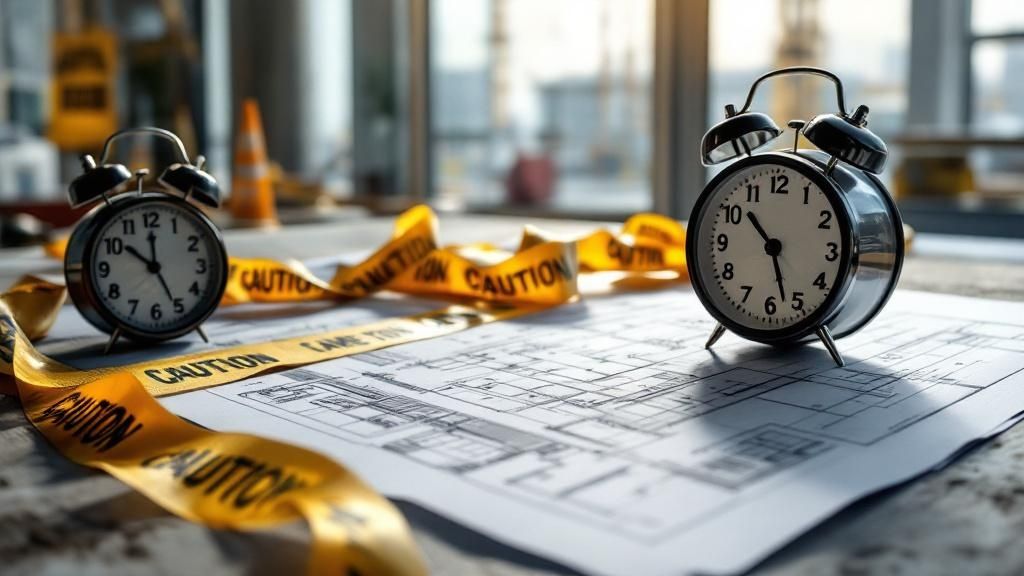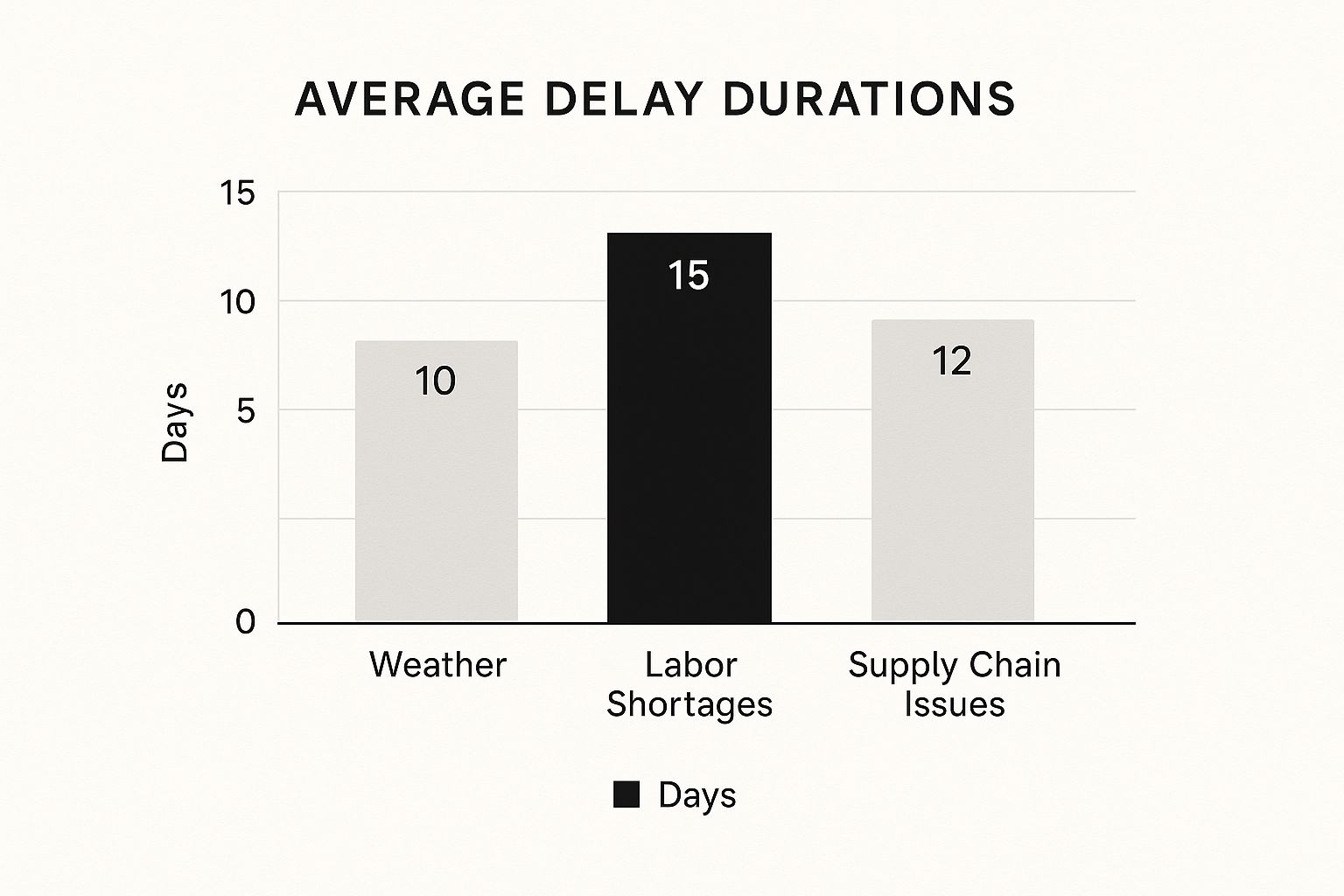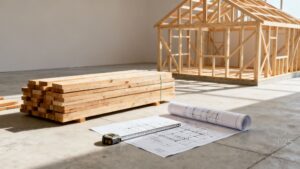No one likes seeing a project timeline slip. It’s one of the most common headaches in construction, but it’s not an automatic sign that something has gone wrong. Construction project delays are a predictable risk you can manage with the right approach. In a market as demanding as the Bay Area, getting smart about these hurdles is the first, most critical step to keeping a project on solid ground.
The Reality of Construction Project Delays

For any builder, contractor, or architect worth their salt, schedule setbacks are a known part of the job. Delays aren't just an annoyance; they're a serious business risk that can snowball, impacting budgets, reputations, and client trust.
This isn't just a local problem. A recent look at 480 major infrastructure projects revealed that a staggering 43% ran late. Those numbers highlight the persistent challenges we all face in planning and execution, no matter where we're building.
The best in the business don't just react to delays—they see them coming. The hallmark of an experienced project manager is building buffers and contingency plans into the schedule from day one.
Why Delays Are So Common in the Bay Area
In dynamic markets like Berkeley, Oakland, and San Francisco, we have our own unique set of challenges that magnify the risk of delays. These issues are often tangled together, creating a web of potential slowdowns that demand an experienced hand. For more tools and insights tailored to our industry, you can check out our dedicated resources for the construction industry.
Here are a few of the key regional headaches we see all the time:
- Volatile Supply Chains: Trying to lock down specialized materials, whether it’s high-performance windows or engineered lumber, can feel like a gamble. A disruption halfway across the world can suddenly stall your Berkeley job site.
- Complex Permitting Processes: It's no secret that Bay Area cities have some of the toughest building codes and longest approval queues in the nation. Navigating this red tape requires deep local knowledge and patience.
- Skilled Labor Gaps: The demand for top-tier trade professionals often outpaces the available workforce, which leads directly to scheduling conflicts and slower work on-site.
Getting a firm grasp on these common causes is where it all begins. When you recognize that construction project delays are a shared reality, not a personal failure, you can start building a smarter framework to manage them.
Common Causes of Bay Area Construction Delays
If you’ve been building in the Bay Area for any length of time, you know that delays aren't just a possibility—they're practically part of the job description. But understanding why they happen, especially the triggers unique to our region, is the only way to get ahead of them.
From San Francisco's dense urban core to specialized remodels in Berkeley, every project has its own set of potential landmines. A two-week permitting snag can easily snowball, throwing off your material orders and leaving your subcontractors waiting.
Navigating Strict Building Codes and Permitting
One of the biggest and most consistent hurdles for construction project delays is the maze of local regulations. Cities like Berkeley and San Francisco are notorious for having stringent building codes that often go beyond state mandates, covering everything from seismic safety to hyper-specific environmental rules.
For example, California's Title 24 energy standards are a hard requirement that dictates your window selection, insulation, and more. If these details aren't baked into the design from day one, you’re looking at costly revisions and a schedule that gets pushed back by weeks. For a deeper dive into these local rules, our guide on the San Francisco construction process is a great resource.
Navigating the permitting process in the Bay Area isn't a sprint; it's a marathon. Submitting applications early and ensuring all documentation is flawless is non-negotiable for keeping a project moving forward.
Climate and Site-Specific Hurdles
The Bay Area’s unique geography and climate bring their own set of challenges. We're in a seismically active zone, which means projects demand specialized, resilient materials and construction techniques that often have longer lead times.
And then there are the surprises lurking just below the surface, especially on urban infill lots or in older neighborhoods. Common culprits include poor soil conditions, undocumented utilities, or hazardous materials like asbestos, each capable of stopping you in your tracks.

Here's a quick look at some of the most common delay triggers we see on Bay Area projects.
Common Delay Triggers in Bay Area Construction Projects
| Delay Trigger | Primary Impact | Initial Mitigation Strategy |
|---|---|---|
| Permitting & Inspections | Timeline Stagnation. Project can't start or move to the next phase. | Submit applications well in advance; use a local permit expediter if possible. |
| Skilled Labor Shortages | Schedule Bottlenecks. Waiting on a specific trade holds up all subsequent work. | Lock in key subcontractors early; maintain strong relationships with reliable trades. |
| Material Supply Chain | Cost & Time Overruns. Long lead times for windows, doors, or engineered wood disrupt the critical path. | Order long-lead items as soon as the design is finalized; confirm availability with your supplier. |
| Unexpected Site Conditions | Budget & Scope Creep. Discovering poor soil or hazardous materials requires immediate, unplanned work. | Build a healthy contingency into the budget and schedule; conduct thorough site investigations. |
| Client Change Orders | Sequential Delays. A "simple" change can impact materials, labor, and subsequent phases of work. | Establish a clear change order process from the start; communicate timeline impacts immediately. |
Thinking through these triggers before you break ground is crucial. It’s the difference between reacting to problems and managing them proactively.
The Ripple Effect of Labor and Supply Chain Issues
Beyond local codes, we're all dealing with the broader industry headaches of labor shortages and supply chain disruptions. In a market as competitive as the Bay Area, finding and scheduling skilled trades can feel like a full-time job.
At the same time, getting a steady supply of materials continues to be a major challenge, with inflation and wild cost fluctuations adding another layer of risk. These problems don't just stretch your timeline; they can blow up your budget and threaten the entire project.
The most common supply chain culprits we see include:
- Specialty Windows and Doors: High-performance or custom-sized units always have long manufacturing lead times.
- Engineered Wood Products: Items like I-joists and LVL can have unpredictable availability.
- Custom Millwork and Finishes: Anything bespoke naturally takes more time to fabricate and deliver.
Anticipating these specific triggers is fundamental for any contractor, architect, or builder working in this demanding region.
The Hidden Costs of a Stalled Project

When a project timeline slips, it’s not just about pushing a date on the calendar. The true cost of construction project delays piles up in ways both obvious and subtle, hitting your bottom line, your reputation, and your ability to land the next job.
Calculating the Direct Financial Bleed
Every extra day on a job site in Oakland or Berkeley has a price tag. The biggest drain is usually the extended labor payroll, but you also have ongoing costs for equipment rentals, site security, and temporary utilities.
And then there are the liquidated damages clauses many contracts include. These are penalties you, the contractor, pay the client for every day the project is late, and they can demolish your profit margin.
Here’s a quick look at where the money goes:
- Extended General Conditions: These are the daily operating costs of the site, from supervision and temporary offices to insurance.
- Material Price Escalation: A delay can mean you end up buying materials when prices are higher, directly eating into your budget.
- Increased Labor Costs: You might face overtime or have to pay premium rates to get the project back on track once you can restart.
A project delay is never just a time problem; it's always a money problem. The longer a project is idle, the more it costs, turning a profitable job into a potential loss.
The Corrosive Impact of Indirect Costs
While direct costs are painful, the indirect or "hidden" costs often do the most long-term damage. These are the things you can't easily track on a spreadsheet, like eroding client trust or a damaged reputation.
Then there's the opportunity cost. While your best crew and capital are tied up on a stalled project, you can't bid on new, profitable jobs. This loss of momentum is a serious blow in a competitive market like the Bay Area. These indirect costs highlight how critical smart planning is, like ordering key components early, which you can learn more about in our guide to choosing energy-efficient windows for Bay Area homes.
Proactive Strategies to Keep Your Project on Track
Knowing what causes construction project delays is one thing; actually preventing them is another. The most powerful shift any Bay Area builder can make is moving from a reactive to a proactive mindset.
The secret isn't hoping for a perfect project, but planning for an imperfect one. It’s about building in buffers, making communication crystal clear, and using your strategic relationships to create a resilient project from the get-go.
Meticulous Pre-Construction Planning
Your best defense against delays happens long before the first shovel hits the dirt. Rushing the pre-construction phase is a common and incredibly costly mistake. This is your golden opportunity to sniff out risks and set realistic expectations.
A huge piece of proactive management is the careful art of creating robust project timelines. A realistic schedule isn't just a laundry list of dates; it's a strategic document that accounts for the unique hurdles we face in the Bay Area.
A strong pre-construction plan must include:
- A Healthy Permitting Buffer: Assume the permitting process in cities like Berkeley or Oakland will take longer than you think. Build that extra time into your critical path from day one.
- A Thorough Site Assessment: Go beyond a quick walkthrough. Invest in geotechnical reports and utility locating services to uncover any nasty surprises before they blow up your schedule.
- A Detailed Scope of Work: Define every aspect of the project with painstaking clarity. Ambiguity is the number one cause of change orders, which are a direct line to delays.
Think of your project schedule like a flight plan. A pilot doesn't just plan for clear skies; they plan for turbulence and headwinds. A great contractor does the same for their project timeline.
Building a Resilient Supply Chain
Your project can only move as fast as your materials arrive. Taking a passive "order and hope" approach to procurement is a recipe for disaster in today's world of unpredictable lead times.
This is where a local expert like Truitt & White becomes an invaluable part of your team. A true partnership gives you access to real-time inventory insights and smart advice on viable alternatives if your first choice is backordered. For a deeper dive, check out The Complete Guide to Professional Contractor Supplies.
Proactive supply chain management looks like this:
- Order Long-Lead Items Immediately: As soon as architectural plans are approved, get orders in for custom windows, doors, and engineered lumber.
- Confirm Availability First: Before a client falls in love with a specific material, call your supplier to confirm its availability and current lead time.
- Coordinate Deliveries Smartly: Work with your supplier to schedule just-in-time deliveries that line up with your project phases.
Implementing Ironclad Communication Protocols
Even the most perfect plan will fall apart without clear and consistent communication. An ironclad communication protocol keeps everyone on the same page and accountable. Your system should be simple, consistent, and documented.
Essential communication practices include:
- Regular Stakeholder Meetings: Set up weekly or bi-weekly check-ins with the client and key team members to review progress and look ahead.
- Disciplined Documentation: Use a single, centralized system for all project documents—plans, change orders, RFIs, and daily logs.
- Immediate Issue Reporting: Create a clear process for how to report a potential delay the moment it's identified. The sooner an issue is on the table, the more options you have to fix it.
By baking these proactive strategies into your daily workflow, you start actively managing risk and steering your project toward a successful completion.
Using Technology to Predict and Prevent Delays

In a market as competitive as the Bay Area, every advantage counts. For today's contractor, the sharpest edge comes from technology, our most powerful tool for getting ahead of construction project delays. Adopting the right tech is about seeing problems before they show up on-site.
Modern tools give us a digital preview of the entire project, letting us spot conflicts and keep communication flowing with pinpoint accuracy.
The Power of Building Information Modeling (BIM)
For complex projects, Building Information Modeling (BIM) is a game-changer. It's a dynamic 3D model packed with intelligent data for every single part of the build.
Before a single trade even steps onto your San Francisco job site, BIM software can run a clash detection analysis. It digitally simulates how all systems fit together, flagging conflicts like a plumbing line that’s on a collision course with an HVAC duct. Catching this in the model saves weeks of headaches and costly rework in the field.
Real-Time Collaboration Between Office and Field
One of the oldest delay culprits is the communication gap between the office and the job site. Cloud-based project management platforms close that gap, creating one source of truth that everyone can access in real-time.
This means:
- Instant Plan Updates: When an architect makes a change, the new plans are pushed to the whole team immediately. No more working off an outdated drawing.
- Seamless RFI and Submittal Tracking: Requests for information (RFIs) and submittals are all handled digitally, killing the paperwork bottlenecks that stall decisions.
- Daily Reporting from Anywhere: Supervisors can upload daily logs and progress photos right from the job site, giving everyone instant visibility.
This constant flow of information helps your team solve problems faster. The right tech stack also helps you choose the best materials for the job. For tips, take a look at our guide on sourcing durable materials for contractors.
Catching Mistakes Instantly with Augmented Reality
Augmented Reality (AR) is a practical tool for quality control that overlays your 3D BIM model directly onto the real-world job site.
Imagine your foreman walking through a newly framed structure in Oakland. With an AR device, they can see a holographic projection of the entire plumbing system exactly where it’s supposed to go, spotting any deviation from the plan in a split second.
This kind of immediate validation is incredibly powerful, ensuring everything is installed with precision. On one project, real-time AR validation caught misinstalled equipment that would have caused a ten-week delay, ultimately recovering 48 critical days. You can find more examples of how construction leaders are beating delays with technology on xyzreality.com.
Your Strongest Defense Is a Strategic Partnership
When it comes down to it, the best way to defend against construction project delays is to have a solid, unified team in your corner. Real success depends on everyone—architects, subcontractors, and especially your building material supplier—working together seamlessly.
Working with a deeply knowledgeable local supplier like Truitt & White means you get more than just materials. You get access to people who can provide expert advice on the right products for the Bay Area's climate and who can manage agile deliveries to keep your crew working. This philosophy has been at the core of our business since the Truitt & White partnership was forged.
Think of a strong supplier relationship as a shock absorber for your schedule. It cushions your project from the jarring bumps of supply chain volatility and helps keep you on the critical path to completion.
Let's start building a resilient supply chain for your next project, together.
Frequently Asked Questions About Construction Delays
Here are straightforward answers to the questions we hear most often from Bay Area contractors, architects, and builders trying to keep their projects on schedule.
1. What is the single biggest cause of project delays in the Bay Area?
While supply chain issues and labor shortages are significant, the most consistent hurdle unique to our region is the permitting process. Cities like Berkeley, Oakland, and San Francisco have complex and slow-moving planning departments. Getting ahead of this with early and meticulous applications is non-negotiable to prevent these specific construction project delays.
2. How can I protect my business financially when delays happen?
Your best defense is a rock-solid contract with clear language on handling extensions and change orders. We also recommend building a contingency fund of at least 5-10% of the project budget, as suggested by the NAHB, to create a crucial financial buffer against unexpected costs.
3. Are certain building materials more likely to cause delays?
Absolutely. Any material that is not a standard, in-stock item can introduce delays. This includes high-performance or custom-sized windows, bespoke millwork and cabinetry, and engineered lumber products like LVLs. Always confirm lead times with your supplier, like Truitt & White, early in the planning phase.
4. What is my first move when a delay seems unavoidable?
Communicate immediately and transparently. The moment you see a potential delay, inform the client and all stakeholders, explain the cause, and present a clear plan to mitigate the impact. Documenting everything in writing creates an official record of the issue and your proactive response.
5. How does a local supplier help me avoid delays?
A local supplier like Truitt & White brings regional expertise that a national chain can't match. We have deep knowledge of Bay Area building codes, strong ties with manufacturers, and logistics built for local challenges. This partnership provides accurate lead times, smart alternatives for backordered items, and reliable deliveries to keep your project moving.
Ready to build a more resilient project plan? The experts at Truitt & White are here to help you navigate material selection and supply chain challenges. Visit our Berkeley showroom or connect with us for expert advice.









